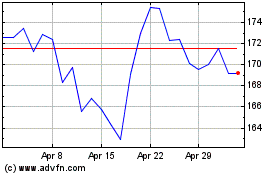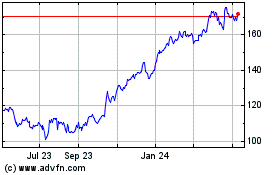Allstate Corporation’s (ALL) fourth-quarter
2011 operating earnings of $1.48 per share came in substantially
higher than the Zacks Consensus Estimate of 94 cents and the
year-ago quarter’s earnings of 50 cents per share.
Results for the quarter reflected lower catastrophe (CAT)
losses, which further led to reduced claims expenses coupled with
higher premiums. These were offset by lower investment income and
policies-in-force in Property-Liability insurance. However,
prudent capital management and liquidity were quite impressive
during the reported quarter. This is reflected from stability in
book value per share and combined ratio, excluding the effect of
catastrophes.
Allstate’s net income for the reported quarter came in at $724
million or $1.43 per share, compared with $296 million or 55 cents
per share in the prior-year quarter, reflecting a radical
ascent.
Operating income, which excludes realized net capital gains and
losses and deferred acquisition costs (DAC) and DSI related to them
along with valuation changes on embedded unhedged derivatives,
gains and losses on disposition of operations and accruals on
non-hedged derivative instruments, spiked up to $750 million from
$271 million in the year-ago quarter.
Allstate reported total net revenue growth of 1.8% year over
year to $8.24 billion but substantially exceeded the Zacks
Consensus Estimate of $6.9 billion. Besides, property-liability
insurance claims and claims expenses declined 13.3% year over year
to $4.2 billion while operating costs and expenses jumped 20.1%
year over year to $1.0 billion.
Particularly, catastrophe losses for the reported quarter
plunged to $66 million from $537 million in the year-ago period.
During the reported quarter, Allstate witnessed catastrophe losses
of $216 million from 19 events, substantially offset by
favorable reserve re-estimates of $150 million.
Quarter in Detail
Property-Liability net written
premiums were $6.43 billion, creeping up 2.9% from the prior-year
quarter. The segment’s combined ratio also improved to 90.7%
against 100.8% in the year-ago quarter, reflecting decreased
catastrophe losses.
However, the underlying combined ratio, which excludes
catastrophes and prior-year reserve estimates, was 90.5% in the
reported quarter, 1.5 points better than the year-ago quarter. This
was also within management’s outlook of underlying combined ratio
of 88% to 91% for 2011.
Besides, Allstate brand standard auto premiums written for the
reported quarter inched down 0.8% from the prior-year quarter as a
result of a reduction in units, fall in policies in force in
Florida and New York along with a 14.3% decline in new issued
applications, although retention improved slightly. However, the
Allstate brand standard auto combined ratio improved 4.2 points
year over year to 95.5%.
Nevertheless, Allstate-branded homeowners’ written premiums for
the quarter climbed 2.8% year over year, reflecting a 7.1% uptick
in average gross premium that was partially mitigated by lower
policies in force. During the reported quarter, rate increases
averaging 7.8% in 17 states were approved as Allstate continued its
initiatives to improve homeowners’ profitability.
Property-Liability net income spiked to $638 million against
$260 million in the year-ago quarter. Operating income for this
segment also surged to $661 million from $206 million in the
year-ago quarter. However, the Property-Liability expense ratio for
the reported quarter weakened to 27.2 from 25.6 in the prior-year
quarter.
However, operating income for Allstate
Financial escalated 32.7% year over year to $138
million. The increase reflected improvement in the profitability of
investment spread products along with expansion of underwritten
products sales through Allstate agencies and growing Allstate
Benefits, which were partially offset by higher operating expenses.
Meanwhile, net income came in at $140 million against $76 million
in the year-ago quarter, primarily driven by higher net realized
capital gains.
Corporate & Other segment reported
a net loss of $54 million, deteriorating from a loss of $40 million
in the prior-year quarter. Total operating cost and expenses stood
at $88 million, as opposed to $86 million in the year-ago
quarter.
Full-Year 2011 Highlights
For full year 2011, Allstate recorded operating net income of
$689 million or $1.32 per share as compared with $1.54 billion or
$2.84 per share in 2010. However, operating earnings per share came
in substantially ahead of the Zacks Consensus Estimate of 81
cents.
Reported net income also declined to $788 million or $1.51 per
share from $928 million or $1.71 per share in 2010. The plunge in
the bottom line was primarily attributable to catastrophe losses
that jumped 72.9% over 2010 to $3.82 billion. Consequently, total
combined ratio weakened to 103.4% from 98.1% in 2010, although the
underlying combined ratio improved by 0.3 points to 89.3% in
2011.
Allstate reported total net revenue growth of 4.0% year over
year to $32.65 billion, although it exceeded the Zacks Consensus
Estimate of $31.34 billion. Total costs and expenses increased 4.6%
over 2010 to $31.68 billion.
Investment and Capital Position
As of December 31, 2011, Allstate’s total investment portfolio
decreased to $95.6 billion from $100.5 billion at 2010-end,
reflecting reductions in the Allstate Financial portfolio and its
fixed annuity business along with the voluntary winding down of
Allstate Bank.
However, the pre-tax net unrealized capital gains jumped to $2.9
billion at the end of 2011 from $1.4 billion at the end of 2010.
The upside reflects the benefit of lower interest rates on fixed
income valuations that was marginally offset by widening credit
spreads and realized gains due to sales of fixed income securities.
Meanwhile, pre-tax net realized capital gains totaled $503 million
in 2011 against $827 million in 2010.
Allstate’s net investment income came in at $4.0 million in
2011, down 3.2% over 2010, although portfolio yields were stable at
4.5% as of December 31, 2011. The reported book value per share
climbed up 4.5% over 2010 to $36.92 in 2011. Book value per share,
excluding the impact of unrealized net capital gains and losses on
fixed income securities, inched up 0.4% to $34.40 at the end of
2011.
Operating cash flow totaled $1.93 billion at the end of 2011,
significantly down from $3.69 billion at 2010-end, while cash stood
at $776 million against $562 million in 2010. Long-term debt stood
at $5.9 billion and total equity was $18.7 billion, while total
assets were recorded at $125.56 billion at the end of 2011.
Capital Deployment
On November 8, 2011, the board of Allstate sanctioned a new
share repurchase program worth $1.0 billion. While the share buy
back will be made through open market operations, it is scheduled
to complete by March 31, 2013. No repurchases were made during the
reported quarter.
The company returned about $1.4 billion through share
repurchases and dividend payouts in 2011. Moreover, the company has
deployed about $20 billion of capital through share repurchases
over the last 17 years.
On January 3, 2012, Allstate paid a regular quarterly cash
dividend of 21 cents per share to shareholders of record as on
November 30, 2011.
Outlook
Management expects to maintain the profitability of the auto
business and improve homeowners’ profitability, resulting in an
underlying combined ratio outlook of 88% to 91% for 2012.
Meanwhile, Allstate aims to generate long-term shareholder value
and an operating return on equity (ROE) of 13% by 2014. As a
long-term growth strategy, management also plans to reposition
products and distribution platforms to meet changing needs of
consumers. Besides, the company’s near-term priorities include
maintaining standard auto margins, improving returns in homeowners
and Allstate Financial besides managing capital aggressively.
Allstate is taking strategic actions to reduce losses for
Allstate business from catastrophes through enhanced property
catastrophe reinsurance program, non-renewals, stricter
underwriting guidelines, increased deductibles and discontinuance
of selected lines of coverage, including earthquake.
We anticipate continued benefits from Allstate’s
diversification, superior financial strength rating and proactive
approach to investment. These factors have helped Allstate gain the
second-largest personal lines writer position in the US, which also
reflects its competitive strength against arch rivals such as
Berkshire Hathaway-A (BRK) and The
Travelers Companies (TRV).
However, Allstate’s exposure to catastrophe risks, capital
losses and volatility in pricing, interest and loss costs will
continue to impact the premiums and investment portfolio in the
upcoming quarters.
ALLSTATE CORP (ALL): Free Stock Analysis Report
TRAVELERS COS (TRV): Free Stock Analysis Report
To read this article on Zacks.com click here.
Zacks Investment Research
Allstate (NYSE:ALL)
Historical Stock Chart
From Jun 2024 to Jul 2024

Allstate (NYSE:ALL)
Historical Stock Chart
From Jul 2023 to Jul 2024
